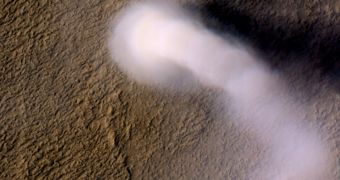A very tall, very narrow dust devil was recently imaged as it was making its way over the Martian landscape, from high above the planet's surface. Even though it reached an altitude of about 20 kilometers (12 miles), the dust devil was not more than 70 meters wide at any point.
The formation was imaged from aboard the NASA Mars Reconnaissance Orbiter (MRO), which has been flying around the Red Planet since 2006. Its High Resolution Imaging Science Experiment (HiRISE) is capable of collecting extremely precise photographs from high altitudes.
This particular view was taken as the orbiter was flying above the Amazonis Planitia region of Northern Mars, on March 14. This time coincides with late spring at the location, researchers from the NASA Jet Propulsion Laboratory (JPL), in Pasadena, California, explain.
They add that the photo was in fact captured about two weeks before the summer solstice. This is a time when the ground receives a lot of heat from the Sun, a phenomenon that promotes the formation of dust devils.
Scientists estimate that such events occur on Mars just as often as they do on Earth, despite the differences between the atmospheres surrounding the two planets. They add that dust devils differ from tornadoes through the fact that they can occur on a clear day.
They are caused by heated air that suddenly starts moving upwards, and meets pockets of cooler air. If the conditions are appropriate, the air begins to rotate. A dust devil forms only when the rotating air mass begins to pick up sand from the ground, making itself visible.
The new HiRISE image shows the phenomenon in clear detail. The twister's long shadow allowed experts to find out more about the inner structure of the dust devil, since their perspective did not really allow for a direct study of its section.
“Now in an extended mission, the orbiter continues to provide insights into the planet's ancient environments and how processes such as wind, meteorite impacts and seasonal frosts continue to affect the Martian surface today,” the JPL team says of the MRO.
“This mission has returned more data about Mars than all other orbital and surface missions combined. Each observation by [HiRISE] covers several square miles, or square kilometers, and can reveal features as small as a desk,” the group concludes.

 14 DAY TRIAL //
14 DAY TRIAL //